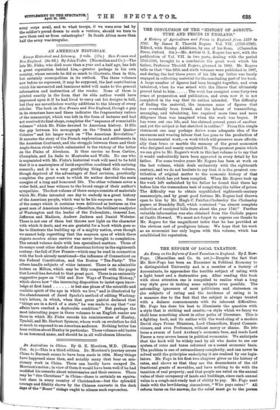THE CONCLUSION OF THE "HISTORY OF AGRICUL- TURE AND PRICES
IN ENGLAND."
A History of Agriculture and Prices in England from 1259 to 1793. By James E. Thorold Rogers. Vol. VII. (1703-1793). Edited, with Sundry Additions, by one of his Sons. (Clarendon Press, Oxford. 50s.)—Mr. Arthur G. L. Rogers has now, with the publication of Vol. VII. in two parts, dealing with the period 1703-1793, brought to a conclusion the great work which his father, Professor Thorold Rogers, planned in 1860. Mr. Rogers tells us that "the fifth and sixth volumes were published in 1887, and during the last three years of his life my father was busily engaged in collecting material for the concluding part of his book. A large number of figures had been brought together, and even tabulated, when he was seized with the illness that ultimately
proved fatal to him The work has occupied some forty-two years of preparation and publication, and even now it is not completed in the way that its author intended. The difficulty of finding the material, the immense mass of figures that has eventually been found, and the labour of transcribing, arranging, and tabulating, has required more time and more diligence than was imagined when the work was begun. It has worn out one life, and has claimed several years of another. and yet the subject is but sketched in outline." From this simple statement one may perhaps derive some adequate idea of the enormous and wearing labour that has gone to the production of this monumental work,—a work which will preserve more effectu- ally than brass or marble the memory of the great economist who designed and nearly completed it. The greatest praise which we can give to Mr. Rogers's work in this last volume is to say that it would undoubtedly have been approved in every detail by his father. For some twelve years Mr. Rogers has been at work on the last volume, which deals exclusively with the eighteenth century, and we do not hesitate to say that it is the greatest con- tribution of original matter to the economic history of that century which has yet been compiled. When Mr. Rogers took up the work left unfinished by his father he found that there lay before him the tremendous task of completing the tables of prices. The difficulty was to obtain unpublished eighteenth-century manuscripts, and by great good fortune Mr. Rogers had thrown open to him by Mr. Hugh C. Fairfax-Cholmeley the Cholmeley papers at Brandsby Hall, which contained "an almost complete collection of receipted bills from about the year 1740." Further valuable information was also obtained from the Carlisle papers at Castle Howard. We must not forget to express our thanks to Mr. Rogers for the magnificent index that he has provided at the obvious cost of prodigious labour. We hope that his work as an economist has only begun with this volume, which has established his reputation.


























































 Previous page
Previous page